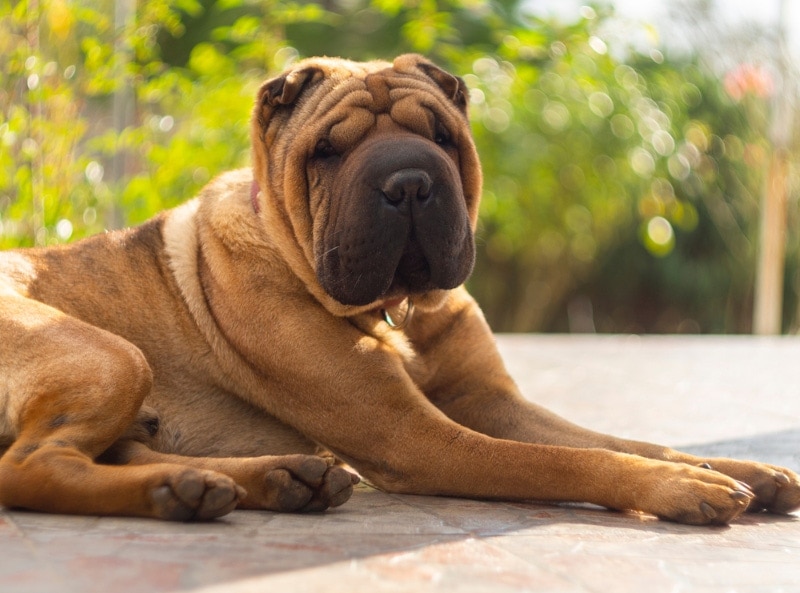How Big Does a Shar-Pei Get? Average Weight & Growth Chart
Updated on

Click to Skip Ahead
This article has been reviewed for factual accuracy by a qualified veterinarian. The views and opinions expressed herein are those of the author and do not necessarily represent the views or opinions of the veterinarian. This article is not designed to replace tailored advice from your veterinarian and does not take into account your pet’s individual circumstances.
One of the first things new puppy owners want to know about their dogs is how big they will be when they’re full-grown. This information impacts everything from pet care budgets to housing rental options. Because they’re bred to a specific standard, it’s easiest to predict the average adult size of purebred dogs, such as the Chinese Shar-Pei.
In this article, we’ll tell you how big a Shar-Pei gets and have growth charts for easy reference. We’ll also cover some factors that can influence how your Shar-Pei puppy grows and their final adult size.
Shar-Pei Breed Overview
The Shar-Pei originated in China and is one of the oldest known domestic breeds, according to DNA studies1. They were initially developed as hunters and guard dogs by Chinese farmers. Shar-Peis remained rare outside of China until they were featured in a magazine article in 1973, leading to a surge of global interest.
They’re famous for their wrinkles and unique coat texture, and Shar-Peis are quiet, independent, and protective dogs. Since they’re stubborn and suspicious of strangers, the Shar-Pei needs experienced handling, early socialization, and patient training. They aren’t the most playful dogs, and kids may find them boring.
Shar-Peis are smart but hard-headed and capable of learning but not always motivated. They adapt their exercise needs to their living situation. Unfortunately, Shar-Peis are prone to several inherited health conditions.

Shar-Pei Size and Growth Chart
Full-grown adult Shar-Peis, male or female, weigh 45–60 pounds and are 18–20 inches tall. You may also see “miniature” Shar-Peis for sale, but they are not breed-standard dogs. In dogs, growth rates vary by size. Shar-Peis are considered medium-large dogs, depending on their full adult size, so their growth rates may vary slightly.
| Age | Weight Range |
| 12 weeks | 13-19 pounds |
| 6 months | 30-45 pounds |
| 9 months | 33-55 pounds |
| 12 months | 40 -58 pounds |
| 16 months | 45-60 pounds |
When Does a Shar-Pei Stop Growing?
Generally, Shar-Peis will reach their full adult height first but continue to gain weight until they stop growing. At 12-18 months they will reach their full adult size.
As is normal for dogs, females are on average a little smaller than males.
Factors Affecting the Size of a Shar-Pei
The adult size of a Shar-Pei’s parents is one of the most significant factors affecting their size. Congenital abnormalities such as heart disease and liver shunts can cause a reduced size. In addition proper parasite control and nutrition are important for healthy growth.

Ideal Diet for Maintaining a Healthy Weight
One of the health conditions that Shar-Peis can inherit is hip dysplasia. To help decrease the severity of this condition in adult Shar-Peis, it’s generally recommended that they eat a large-breed puppy diet. Puppy food is designed to maintain a steady growth rate, giving the joints and muscles ample time to develop and strengthen. Follow the feeding guidelines on your bag of dog food and adjust if your dog appears too lean or overweight.
Inadequate nutrition, such as feeding a puppy a brand meant for adult dogs, can lead to improper development and a smaller-than-average Shar-Pei. Puppy formulas contain more protein and calories than adult diets to fuel rapid growth.
Once fully grown, Shar-Peis can be prone to obesity if overfed or not very active. Talk to your vet about when to switch from a puppy to an adult diet. Once desexed, the calorie requirements are also lower. Your vet can also help you calculate how many calories your Shar-Pei should eat to maintain a healthy weight.
How to Measure Your Shar-Pei
Like horses, a dog’s height is measured to the withers, or the top of their shoulders, down to the ground. To determine your Shar-Pei’s length, measure from the base of the neck to the base of the tail. The measurement does not include their tail length, but Shar-Peis carry their tails curved over their bodies anyway.
While your puppy is young, it’s easy to keep up with their weight because they will frequently see the vet for vaccines and other preventative care. If you want to weigh your puppy at home, using a pet scale is most accurate, but you could also place them in a carrier or box and use a standard bathroom scale.
Place the carrier or box on the scale, zero out the reading, and then place your dog in the receptacle to obtain their weight. You can also weigh the dog and box together first, then weigh the empty carrier or box and subtract that number to determine your dog’s weight.
Once your Shar-Pei is too big to weigh on a standard bathroom scale, you may need to keep track of their weight by regularly stopping by the vet’s office for weigh-ins.
Conclusion
A full-grown Shar-Pei typically weighs 45–60 pounds. Like most medium-large breed dogs, they can take over a year to reach adulthood and stop growing. Until then, you can expect to go through different-sized collars, beds, crates, and food bowls. Budgeting to replace your puppy’s gear as they grow is just one of the expenses impacted by the Shar-Pei’s growth rate.
Featured Image Credit: David Raihelgauz, Shutterstock











